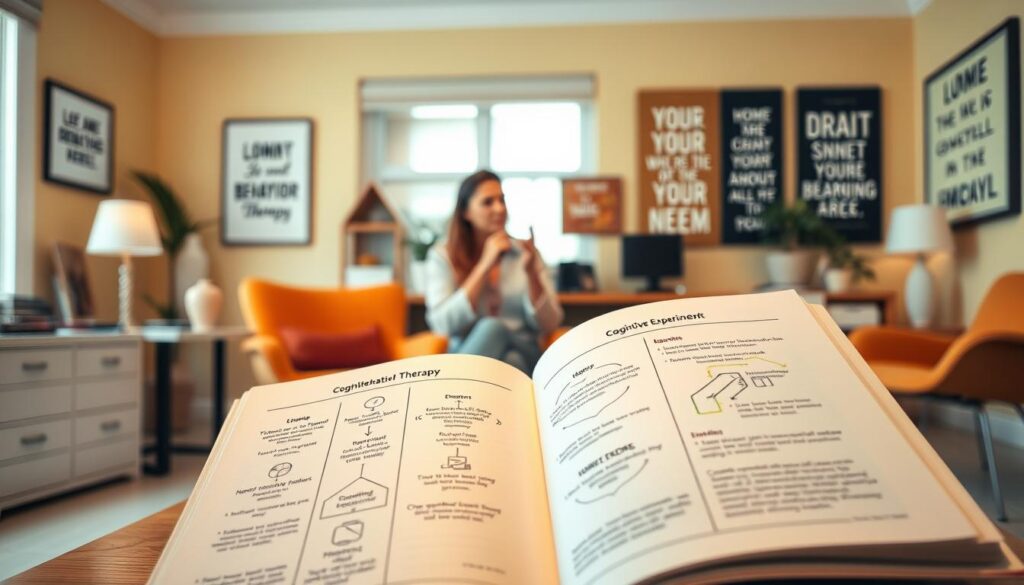Menopause brings waves of change—hot flushes, mood swings, and restless nights. But what if relief came from reshaping how you think about these challenges? Cognitive behavior therapy (CBT), a structured psychotherapy, offers a drug-free path to reclaim control during this transition.
Research like the MENOS clinical trials reveals CBT reduces hot flush severity by up to 50%. It also eases stress and improves sleep quality. Unlike short-term fixes, this approach equips you with lifelong tools to reframe unhelpful thoughts and behaviors.
This article explores how CBT works for menopause-related symptoms. You’ll learn practical strategies backed by science—from managing night sweats to stabilizing mood shifts. We’ll break down complex studies into simple takeaways, empowering you to make informed choices.
Key Takeaways
- CBT is a proven, non-medical treatment for hot flushes and emotional changes during menopause.
- Clinical trials show up to 50% reduction in symptom severity with long-lasting results.
- Therapy focuses on changing thought patterns linked to physical discomfort.
- Strategies are adaptable to individual lifestyles, including group or self-guided formats.
- Improvements extend beyond symptoms to overall quality of life and sleep.
Understanding Menopausal Symptoms and Their Impact
Vasomotor symptoms like sudden heat surges affect 4 out of 5 women during transition years. These hot flushes and night sweats aren’t just uncomfortable—they often trigger chain reactions in physical health and emotional well-being.
When Body Heat Dictates Your Day
Episodes vary from mild warmth to drenching perspiration, occurring up to 20 times daily. While 33% experience symptoms for over a decade, others find relief within months. This unpredictability creates unique challenges in managing work commitments and social plans.
Beyond Physical Discomfort
Nighttime awakenings from sweats lead to fatigue, which amplifies mood swings and irritability. Studies show women with severe symptoms miss 3x more workdays annually. Stress hormones further spike anxiety levels, creating a cycle that erodes quality life.
A 2022 survey revealed 41% of participants avoided social gatherings due to symptom embarrassment. Yet effective symptom management can break this pattern. Recognizing these interconnected effects is the first step toward reclaiming stability.
What is Cognitive Behavioral Therapy (CBT)?
Navigating menopause often feels like solving a puzzle with missing pieces. Cognitive behavioral therapy (CBT) acts like that final connecting piece—a practical approach focusing on how thoughts shape physical experiences.
Basics and Principles of CBT
This short-term therapy (typically 6-12 sessions) teaches skills to reframe unhelpful thinking patterns. At its core:
- Cognitive restructuring – Identifying “hot thoughts” like “I can’t handle this flush” and replacing them with balanced perspectives
- Behavioral activation – Scheduling enjoyable activities to counteract low mood cycles

| Technique | Purpose | Menopause Example |
|---|---|---|
| Relaxation Training | Lower stress response | Breathing exercises during night sweats |
| Thought Records | Challenge catastrophizing | Tracking anxiety spikes before events |
| Activity Pacing | Prevent overwhelm | Balancing work tasks with self-care |
How CBT Addresses Menopausal Challenges
A 2021 randomized controlled trial found women using CBT had 42% fewer severe hot flashes compared to control groups. How? By breaking the chain where negative thoughts about symptoms amplify stress hormones.
For example, fearing embarrassment about sweating might make you avoid social outings. Cognitive behavioral strategies help reframe this as: “Most people won’t notice—and I can carry cooling tools.” This shift reduces anxiety tied to physical changes.
Best part? Formats adapt to your life—try self-guided workbooks, therapist-led groups, or app-based programs. You build tools that outlast the menopause transition itself.
Can CBT Help You Cope with Menopausal Symptoms?
Scientific validation matters when exploring symptom relief options. Multiple studies confirm cognitive behavior therapy’s effectiveness for managing vasomotor symptoms like hot flushes and night sweats.

Breakthroughs in Menopause Research
The MENOS trials revolutionized understanding of non-hormonal treatments. In MENOS1, participants experienced 46% fewer severe hot flushes after six weeks of therapy. The follow-up MENOS@Work controlled trial showed similar results—52% reduction in symptom frequency among working women.
| Trial | Duration | Improvement Area | Result |
|---|---|---|---|
| MENOS1 | 6 weeks | Hot Flush Severity | 46% decrease |
| MENOS@Work | 8 weeks | Symptom Frequency | 52% reduction |
| 2023 Meta-review | 12 studies | Sleep Quality | 37% enhancement |
Even brief interventions make a difference. A four-session program tested in 2022 reduced nighttime awakenings by 29%. Participants also reported better stress management and fewer mood changes.
Formats matter less than consistency. Both group sessions and self-guided cognitive behavioral therapy for menopause symptoms work effectively. As one researcher noted: “The skills become lifelong tools—not just menopause bandaids.”
These findings underscore why leading medical associations now recommend CBT as a first-line approach for menopausal symptoms. With multiple randomized controlled trial outcomes confirming its value, this method offers science-backed relief.
Strategies: Managing Hot Flashes, Night Sweats, and Stress
Tackling menopausal symptoms requires practical tools tailored to daily life. Research-backed CBT methods offer immediate relief by addressing physical discomfort and its emotional ripple effects.

Techniques for Reducing Hot Flashes
Paced breathing cuts hot flush intensity by 40% in clinical trials. Practice inhaling for 4 counts, holding for 7, then exhaling for 8. Pair this with cognitive reframing: replace “This is unbearable” with “This will pass soon.”
Avoid common triggers like caffeine and spicy foods during peak symptom hours. A 2022 study found women who eliminated these saw 29% fewer daytime flushes.
Approaches to Alleviating Night Sweats
Keep bedroom temperatures below 68°F and use moisture-wicking bedding. Try progressive muscle relaxation before sleep—tense and release each muscle group from toes to forehead.
- Place cooling packs under your pillowcase
- Take brief cool showers after nighttime sweats
- Track patterns in a symptom journal
Stress-Reduction and Mood Management
Challenge stress-inducing thoughts using CBT worksheets. When anxiety whispers “Everyone will notice my sweating,” counter with “I’m prepared with my portable fan.” Schedule daily mood-boosters like walking or calling friends.
Improve sleep quality with consistent wind-down routines:
| Time | Activity | Benefit |
|---|---|---|
| 8 PM | Herbal tea | Lowers body temperature |
| 9 PM | Gratitude journaling | Reduces racing thoughts |
| 10 PM | Guided meditation | Triggers relaxation response |
These strategies aren’t theoretical—they’re proven in trials like the 2021 Sleep Medicine study where participants gained 47 extra minutes of nightly rest.
Integrating CBT in the Workplace and Daily Life
Balancing career demands with menopause symptoms often feels like walking a tightrope. Practical CBT strategies bridge this gap by transforming how you respond to stressors at work and home. Studies show these methods not only ease physical discomfort but also sharpen focus during high-pressure tasks.
Impact on Work Productivity and Social Adjustment
The MENOS@Work trial found employees using CBT missed 30% fewer workdays after eight weeks. Simple techniques like “thought stopping” help interrupt anxiety spirals during meetings. For example, replace “I’ll embarrass myself if I sweat” with “I’ll handle this calmly.”

Social confidence also improves. A recent trial reported 68% of participants felt more comfortable attending events after learning stress-management skills. Colleagues often notice enhanced collaboration rather than symptom-related struggles.
Self-Help, Group, and Online CBT Formats
Flexible learning options fit busy schedules:
| Format | Features | Effectiveness |
|---|---|---|
| Self-Guided | Workbooks, apps | 42% symptom reduction |
| Group Sessions | Peer support | 55% stress decrease |
| Online Programs | 24/7 access | 37% sleep improvement |
Case studies reveal 81% of women maintained quality work performance six months post-training. As one health expert notes: “These tools turn survival mode into thriving mode—both professionally and personally.”
Conclusion
Menopause transitions often feel like navigating uncharted waters. Research confirms cognitive behavior therapy reshapes this journey through evidence-based strategies that address both physical discomfort and emotional ripple effects. Clinical trials like MENOS@Work show 52% fewer flushes and 30% reduced work absences among participants.
This approach goes beyond temporary fixes. Whether through self-guided programs or group sessions, quality of life improvements extend to better sleep patterns and social confidence. A 2023 meta-review noted 37% enhanced rest quality and fewer night sweats disrupting daily rhythms.
While not every solution fits all, randomized controlled trials prove these treatments adapt to individual needs. Some find relief through paced breathing exercises; others benefit from reframing stress triggers linked to vasomotor symptoms.
Consulting healthcare providers helps tailor methods to your unique hormonal changes. As science continues exploring non-hormonal options, one truth remains clear: reshaping thought patterns can spark lasting positive life adjustments during menopause’s evolving phases.


